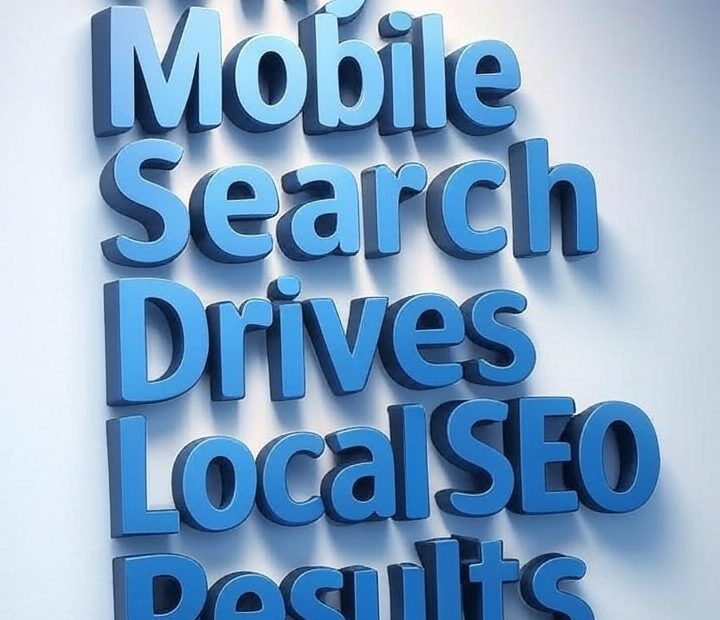Over the past decade, the rise of smartphones has completely transformed how people search for local businesses. Whether someone is looking for the nearest coffee shop, dry cleaner, or urgent care clinic, chances are they’re doing it from a mobile device—and they want results fast.
Today, mobile search is no longer just a trend—it’s the heartbeat of local SEO. Businesses that fail to prioritize mobile optimization are likely missing out on a huge share of high-intent, ready-to-convert local traffic.
In this article, we’ll break down why mobile search is such a powerful force in local SEO and how you can leverage it to drive foot traffic, calls, and conversions from local customers.
📱 Mobile Search: The New Local Front Door
According to Google, over 60% of all Google searches are now performed on mobile devices. When it comes to local searches, that number is even higher. Searches like:
-
“restaurants near me”
-
“open now gas station”
-
“plumber in [city]”
are dominated by users on smartphones who are ready to act immediately. These people aren’t just browsing—they’re looking for a quick solution nearby.
This behavior gives local businesses a golden opportunity to attract customers at the moment of highest intent.
🔍 Google’s Local Results Are Designed for Mobile
Google’s mobile search experience is tailored to highlight local businesses. When a user performs a local search on mobile, they often see:
-
Local Pack (Top 3 listings with a map)
-
Google Maps integration
-
Click-to-call buttons
-
Directions and hours right in the SERP
-
Mobile-friendly business profiles
This format is made for speed, relevance, and convenience—and if your business is properly optimized, you can claim valuable screen space that converts.
💥 How Mobile Search Directly Impacts Local SEO
Here are some specific ways mobile search drives local SEO results in 2025:
1. “Near Me” Searches Have Exploded
Searches with “near me” or “close by” modifiers have grown more than 500% in recent years. These typically happen on mobile, and Google knows it.
To capitalize:
-
Add geo-targeted keywords (e.g., “best Thai restaurant in Chicago Loop”)
-
Ensure your Google Business Profile is fully optimized
-
Use location schema on your website
If you’re not showing up in “near me” results, you’re missing your most valuable leads.
2. Mobile Users Have Immediate Intent
Unlike desktop users, mobile users want immediate solutions. A person searching for “urgent care near me” is likely sitting in their car or walking nearby.
You must make your listing:
-
Easy to navigate on mobile
-
Have clear calls-to-action (call, get directions, order now)
-
Load fast (within 2–3 seconds)
Every second counts when someone’s trying to make a decision while on the go.
3. Voice Search Is Mobile-Driven
With smart assistants like Siri, Google Assistant, and Alexa, voice searches like:
-
“Where’s the closest pet store?”
-
“Find a barber near me open now”
-
“What time does [business] close?”
are becoming more common—and 70% of these are done via mobile.
To rank for voice:
-
Write conversational content
-
Answer common questions on your site (FAQ pages)
-
Use structured data and local keywords
4. Mobile-Friendliness Is a Google Ranking Factor
Google’s mobile-first indexing means that your mobile version of your website is what gets crawled and ranked, not your desktop site.
If your site isn’t mobile-friendly:
-
You’ll drop in rankings
-
Users will bounce quickly
-
You’ll lose leads to competitors
Make sure your site:
-
Uses responsive design
-
Loads quickly
-
Has tappable buttons
-
Easy-to-read fonts
Run your site through Google’s Mobile-Friendly Test to check.
🧩 How to Optimize for Mobile-Driven Local SEO
Now that we understand the why, here’s the how. Follow these steps to boost your local visibility through mobile search:
1. Optimize Your Google Business Profile (GBP)
Include:
-
NAP (Name, Address, Phone) consistency
-
Business hours (including holidays)
-
High-quality photos
-
Primary and secondary business categories
-
Menu/reservation/appointment links
This is often the first thing mobile users see—make it count.
2. Focus on Fast Mobile Page Speed
Mobile users are impatient. Use:
-
Lightweight themes
-
Compressed images
-
Lazy loading
-
AMP (Accelerated Mobile Pages) if needed
Tools like PageSpeed Insights and GTmetrix help you audit and fix issues.
3. Use Mobile-Friendly CTAs
Make it easy to:
-
Click-to-call
-
Get directions
-
Reserve a table or schedule an appointment
-
Chat with your team
Your CTA buttons should be big, bold, and above the fold on mobile.
4. Create Location-Based Landing Pages
If you serve multiple areas, create separate pages for each location with:
-
City-specific content
-
Customer reviews
-
Embedded Google Maps
-
Localized schema markup
This helps you show up in mobile searches across multiple neighborhoods.
5. Leverage Mobile Ad Extensions in Google Ads
If you run Google Ads for local keywords, use mobile ad extensions like:
-
Call extensions
-
Location extensions
-
Lead form extensions
They help users act immediately—without even visiting your website.
🚀 Final Takeaway: Mobile Search IS Local SEO
In 2025, there’s no separating mobile from local. The majority of local search happens on mobile, and the businesses that understand and adapt to this reality will win the visibility game.
Think mobile-first. Make it simple, fast, and useful for people looking for services near them.
When you do, you’ll not only boost rankings — you’ll drive real-world results like more calls, more visits, and more loyal local customers.
Also, you can learn more about Local SEO here.
